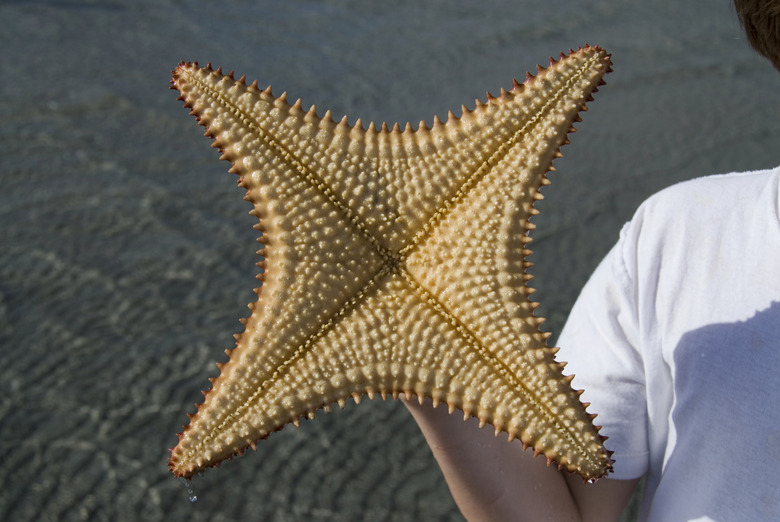What Are The Functions Of The Ampulla On A Starfish?
Starfish (or sea stars) are members of Phylum Echinodermata that are generally predatory and able to move about. They use tube feet on their arms to help them move, and each tube foot contains what is called an ampulla. These ampulla move water into the tube feet to help stretch them.
Starfish stand apart from their echinoderm relatives due to their relatively free movement and flexibility. They endure because of their unique ability to regenerate lost limbs that they can sacrifice to predators.
Facts About Starfish
Facts About Starfish
Starfish (or sea stars) are echinoderms belonging to Class Asteroidea. There are more than 1600 species. Starfish are invertebrates, not fish, but they have endoskeletons. They possess small spines on their bodies, and dermal gills for respiration.
Starfish function without brains. Rather than possessing a central nervous system, they use a nerve ring with branches to their arms. They have rudimentary eyespots.
Unique Starfish Features
Unique Starfish Features
While many starfish have five arms, giving them their name, they can have many more. They possess radial symmetry as adults, but as larvae they are bilaterally symmetric. Starfish are able to regenerate their limbs. Their tissue can change from hard to soft as needed for defense.
While they are quite different, sea urchins, sea cucumbers and sand dollars are also members of the same phylum as starfish. Common features shared with starfish include the radial symmetry, spines and tube feet. Starfish do not wriggle their arms to help them move.
Starfish Feeding Behavior
Starfish Feeding Behavior
Starfish are typically predatory animals. They move along the bottom of the sea searching for immobile or slow prey, such as clams and mussels. Starfish are able to squeeze into tiny openings, making them efficient at opening the shells of mollusks.
For digestion, many starfish function in an unusual way. Starfish have a flat, pentagonal pyloric stomach over another stomach, called the cardiac stomach.
When starfish eat, they extend their cardiac stomachs out of their bodies over prey. After the prey is digested a bit outside, the starfish brings its stomach back inside again for glands to finish the process.
Some starfish also prey upon corals. This can lead to significant coral reef destruction. One such culprit is the Crown of Thorns starfish (Acanthaster).
What Are Ampulla?
What Are Ampulla?
An ampulla can be defined as a saclike pouch in anatomy. In human anatomy, ampulla is defined as pertaining to the common bile duct. The common bile duct transports bile from the liver and gallbladder.
Eventually the bile makes its way to the duodenum. The place where the common bile duct and the pancreatic duct meet in the major duodenal papilla is called the ampulla of Vater.
In starfish, ampulla are small bulblike structures found in the tube feet of the animals. They work to help propel the animals forward.
Starfish Use Ampulla For Locomotion
Starfish Use Ampulla For Locomotion
Starfish need to get around, and yet starfish function with no skeleton to do so. Tube feet are the parts of a starfish that help it to move about on the ocean floor. The tube feet of starfish can be found on their ventral side. A tube foot contains an ampulla or small bulblike appendage.
This ampulla works to push water into the tube foot. As a result, the tube foot stretches out. Muscles in the tube feet help shorten them and the starfish can move forward. As the tube feet move, they release compounds to help attach the foot to a substrate.
Another substance is released to help release the tube foot. The process works as though they glue and unglue themselves over a surface. Starfish are amazing invertebrate predators of the seafloor.
References
- Smithsonian Science Education Center: All About Starfish
- Merriam-Webster: Definition of Ampulla
- RSNA: Imaging Features of Benign and Malignant Ampullary and Periampullary Lesions
- National Cancer Institute: Common Bile Duct
- Tulane University: Introduction to Echinoderms
- UC Museum of Paleontology: Introduction to the Asteroidea
Cite This Article
MLA
Hermance, Dianne. "What Are The Functions Of The Ampulla On A Starfish?" sciencing.com, https://www.sciencing.com/functions-ampulla-starfish-8788738/. 8 July 2019.
APA
Hermance, Dianne. (2019, July 8). What Are The Functions Of The Ampulla On A Starfish?. sciencing.com. Retrieved from https://www.sciencing.com/functions-ampulla-starfish-8788738/
Chicago
Hermance, Dianne. What Are The Functions Of The Ampulla On A Starfish? last modified March 24, 2022. https://www.sciencing.com/functions-ampulla-starfish-8788738/
